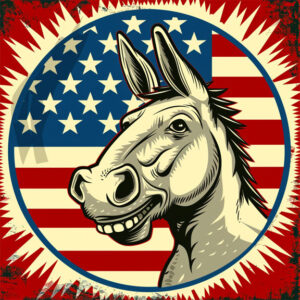 Back in 2012 I wrote For Better or Worse Reasoning: A Philosophical Look at Same-Sex Marriage in response to the debate over this issue and this is a good time to look back on this debate. Especially since members of the Supreme Court have signaled their interest in undoing it.
Back in 2012 I wrote For Better or Worse Reasoning: A Philosophical Look at Same-Sex Marriage in response to the debate over this issue and this is a good time to look back on this debate. Especially since members of the Supreme Court have signaled their interest in undoing it.
One set of arguments against allowing same-sex marriage involved the alleged harms that would arise. Some of these arguments fully embraced the slippery slope fallacy, often to an absurd degree. This fallacy is when it is claimed that something, usually a bad thing, must inevitably follow from something else and this claim of inevitability is not adequately supported. For example, some people claimed that if same-sex marriage was allowed, then this would lead to bestiality and people marrying animals. They did not offer a casual account of how this would come about.
While these claims might strike people as silly, they are testable. As same-sex marriage has been legal for about twenty years, we would expect to see evidence of these outcomes if the claims were true. None of these claims seem to have come true. For example, people still cannot legally marry animals. It could be objected that twenty years has not been long enough for these harms to come about, but they will still occur in the future. But if this were true, there should be at least some evidence of changes heading in that direction (other than the legalization of same-sex marriage) and these are lacking. This is as expected by anyone who thought seriously about these slippery slope arguments.
Another set of arguments against same-sex marriage were built on more reasonable claims of harms that would arise from allowing same sex-marriage. This sort of argument does have appeal, as one purpose of law is to protect people from harm. The reasoning was that if same-sex marriage was allowed, then it would reduce the value of marriage for same-sex couples, leading to less marriage, more cohabitation and more divorce. These claims can now be tested empirically: if they are true, we would expect a statistically significant change in marriage, cohabitation and divorce that could not be explained by other factors.
As would be expected, this data has been collected and analyzed. Instead of a decrease in marriage among different-sex couples, there has been about a 2% increase, with a 10% increase in all marriages. Cohabitation has increased from 0-10%, although it is also worth considering economic factors such as the high cost of rent. It is also worth noting that whether unmarried cohabitation is a negative thing is debatable. Lastly, there has been no consistent change in the divorce rate of different-sex couples. So, by the standards of harms presented in the arguments against same-sex marriage, allowing it seems to have had a slight positive impact in that there has been a 2% increase in marriage among different-sex couples. Back in 2012, this is what I expected as it did not make sense that a significant number of people would give up on marriage or get divorced simply because same-sex couples could legally marry. But expectation is not confirmation, so it is good to see the evidence.
It could be countered that 20 years has not been enough time for the harm to come into effect and that the destruction of marriage will arrive at some point. The obvious reply is that we should see some signs of this trend and we do not. As such, these harm arguments have been shown to be in error. Because of this, attempts to eliminate same-sex marriage based on these claims about harms would be unjustified. But this probably does not matter; I infer that if the fight over same-sex marriage becomes a thing again, these same claims will be made, and the facts will be ignored by those making the argument. This is because that is the same tactic now used by those who argue against transgender rights—they make false claims about harms. But, of course, there were other arguments made against same-sex marriage.
Another set of arguments are those built around religion. One argument is based on the idea that since God married Adam to Eve, this defines marriage in the biblical sense. Clever folks like to say that it was “Adam and Eve, not Adam and Steve.” Since marriage is supposed to be defined by the Christian faith as between one man and one woman, that is what the law should be.
Another common approach is to refer to Leviticus: “thou shalt not lie with mankind, as with womankind: it is abomination.” From this it is inferred that same-sex marriage is wrong and should be illegal. Naturally, witty folks like to point out that Leviticus claims lobster is also an abomination “Whatsoever hath no fins nor scales in the waters, that shall be an abomination unto you.” And sex with lobsters is also right out: “Neither shalt thou lie with any beast to defile thyself therewith: neither shall any woman stand before a beast to lie down thereto: it is confusion.” As far as what Jesus said about same sex relations, he said nothing. This can be confirmed by reading through the New Testament.
Today, the religious arguments are mostly used by people who do not want to have same-sex couples as customers, and these have been used with some success. This does keep the door cracked for using religious arguments against same-sex marriage, especially with the growing success of Christian Nationalism. There are also normative arguments that are not based explicitly on religion.
These arguments include the general argument style in which it is contended that homosexuality is morally wrong and hence they should not be allowed to marry. An obvious concern about this sort of argument is that if people must pass a moral test to be eligible for marriage, then consistency would require applying the same sort of standard to same-sex couples. But as people tend to ignore concerns about consistency, we can expect to see a return of the immoral argument. There is, however, the fact that most Americans do not see homosexuality as immoral, so the moral argument against same-sex marriage would be harder to make in the future.
A variation of the moral argument is the unnatural argument, although this seems to be rarely used for same-sex marriage debates these days. It does, however, get deployed in the culture war over gender and sexual identity so it could get redeployed when the right decides to take on same-sex marriage again. The unnatural argument usually takes the form of claiming that because homosexuality is alleged to not occur in nature, it is unnatural and hence wrong. That homosexuality is widespread in the natural world undercuts this sort of argument, but this does not mean that people will not use it again. As noted earlier, the culture war fight over gender issues involves appeals to what people think is natural, even when they are wrong. As such, this argument type might be used once again.
While there are many other stock arguments used against same-sex marriage, I’ll close with the procreation argument.
Obviously enough, same-sex couples cannot have children through heterosexual intercourse with each other and this inability to procreate was used to argue against same-sex marriage. One example is that during the hearing regarding Proposition 8 in California the claim that “responsible procreation is really at the heart of society’s interest in regulating marriage” was brought out to defend that proposition.
Same-sex marriage was typically criticized on two grounds relating to procreation The first is that same-sex couples cannot, as noted above, procreate with each other by intercourse. The second is that same-sex couples will be bad parents (for example during the battle over Proposition 8, it was claimed without evidence, that homosexuals are twelve times more likely to molest children).
What if we suppose that these two principles are correct: 1) marriage is to be denied to those who do not procreate and 2) people who are not “responsible in procreation” are to be denied marriage.
The first principle would entail that straight couples who do not want children or cannot have them must be denied marriage. It would also seem to imply that couples who use artificial means to reproduce (such as in vitro fertilization or a surrogate) must also be denied marriage.
The second principle entails that straight couples who are not responsible parents must also be denied marriage. This would seem to require that the state monitor marriages to determine that married couples are both reproducing and being responsible parents. The state would presumably need to revoke marriage licenses for those who fail to meet the standards (much like the state can revoke a driver’s license for driving violations). While I obviously think the state has a role in child welfare, being a bad parent (or even a bad spouse) would not seem to warrant taking away the right to marriage.
Of course, these arguments seem to have been made in bad faith since those who opposed same-sex marriage did not put forth comparable legislation addressing same-sex couples who did not reproduce or who were bad parents. This suggests that they did not really care about procreation and good parenting as requirements for marriage, these were simply rhetorical tools to attack same-sex marriage.
Those familiar with the current culture war battles over gender issues will have noticed that people still advance a procreation argument against transgender people, usually in the form of memes and social media posts. Aside from the change of target, it is the same argument used against same-sex couples. The argument is that if everyone was trans, then humanity would die off. So being trans is bad and presumably should not be allowed. A little reflection shows how easily this argument is reduced to absurdity. After all, if it was good logic, it would also apply to anyone who has chosen celibacy (like certain monks, priests and nuns) or people who just do not want to have children. In general, the “it would be bad if everyone did X so we must not allow X” arguments are terrible. After all, it would be bad if everyone became a construction worker, since then we would have no one doing any other jobs. But that obviously does not show that we should ban people from being construction workers.
While this sort of argument is bad, the fact that it still gets employed in the culture war over gender identity shows that it is ready to be redeployed in a refight of the culture war over same sex marriage. People who accept it in one context of the current culture war are presumably primed to consider it in another context of the culture ware.
In closing, while the dire predictions made by those opposing same-sex marriage did not come true, this might not matter much if the fight over same-sex marriage is restarted by the right. While same-sex marriage is broadly accepted and most Americans are at least tolerant of homosexuality, it would be foolish for people who agree with same-sex marriage remaining legal to assume that the fight has been settled. It is reasonable to expect that this front of the culture war to be re-opened and that the same old tired and discredited arguments will be once again deployed in the fight. Culture war never changes
 In what seems to be a victory for Christian Nationalists, the Ten Commandments must now be displayed in Louisiana public classrooms. This law will be challenged, but its proponents are hoping that the Supreme Court will rule in its favor. Given the ideology and religious views of the majority of the court, this victory is all but assured.
In what seems to be a victory for Christian Nationalists, the Ten Commandments must now be displayed in Louisiana public classrooms. This law will be challenged, but its proponents are hoping that the Supreme Court will rule in its favor. Given the ideology and religious views of the majority of the court, this victory is all but assured. 
 While philosophers and religious thinkers have taken past lives seriously, it is usually assumed that serious scientists are happy to leave them to it. But the
While philosophers and religious thinkers have taken past lives seriously, it is usually assumed that serious scientists are happy to leave them to it. But the  Almost as if to prove that anything can become a front in the culture war, milk is part of the endless battle. Back in 2017, white supremacists were chugging milk as a demonstration of their whiteness and some
Almost as if to prove that anything can become a front in the culture war, milk is part of the endless battle. Back in 2017, white supremacists were chugging milk as a demonstration of their whiteness and some  Last Week Tonight With John Oliver recently did an episode on deep sea mining
Last Week Tonight With John Oliver recently did an episode on deep sea mining Back in 2012 I wrote
Back in 2012 I wrote  Trump and his allies have claimed that the Democrats are engaged in
Trump and his allies have claimed that the Democrats are engaged in  In politics, it is said that perception is reality. But many philosophers will tell you that what we think is reality is just perception. Very concisely, the notion is that we never directly experience reality, only the ideas in our mind. As such, we do not really perceive people, including Trump and Biden. We just have ideas of them that probably do not match reality. But, laying aside skepticism, we can have ideas that are more or less accurate. Before continuing, I will note that I am a registered Democrat (Florida has closed primaries) and I voted for Joe Biden last election. I’ll be voting for him again. As a philosopher, I’m obligated to present these biases so you can use them to rationally assess my credibility.
In politics, it is said that perception is reality. But many philosophers will tell you that what we think is reality is just perception. Very concisely, the notion is that we never directly experience reality, only the ideas in our mind. As such, we do not really perceive people, including Trump and Biden. We just have ideas of them that probably do not match reality. But, laying aside skepticism, we can have ideas that are more or less accurate. Before continuing, I will note that I am a registered Democrat (Florida has closed primaries) and I voted for Joe Biden last election. I’ll be voting for him again. As a philosopher, I’m obligated to present these biases so you can use them to rationally assess my credibility. When accused of racism, Republicans often claim that the Democrats are the real racists. To back this up, it is sometimes claimed that the Democrats are “the party of the Ku Klux Klan.” While I don’t think that Ted Cruz invented this tactic, he did push it into the spotlight back when he defended Jeff Sessions against accusations of racism. Cruz went beyond merely claiming that Democrats formed the Klan; he also claimed the Democrats were responsible for segregation and Jim Crow laws. As Cruz saw it, the Democrats’ tactic is to “…just accuse anyone they disagree with of being racist.”
When accused of racism, Republicans often claim that the Democrats are the real racists. To back this up, it is sometimes claimed that the Democrats are “the party of the Ku Klux Klan.” While I don’t think that Ted Cruz invented this tactic, he did push it into the spotlight back when he defended Jeff Sessions against accusations of racism. Cruz went beyond merely claiming that Democrats formed the Klan; he also claimed the Democrats were responsible for segregation and Jim Crow laws. As Cruz saw it, the Democrats’ tactic is to “…just accuse anyone they disagree with of being racist.” In the United States, the left seems to dominate comedy. Comedians like
In the United States, the left seems to dominate comedy. Comedians like  Another criticism of teachers’ unions is that they spend millions of dollars lobbying politicians to protect and advance their interests. This is bad, or so the reasoning goes, because the interests of the teachers’ unions are often (or perhaps even always) contrary to what is best for students.
Another criticism of teachers’ unions is that they spend millions of dollars lobbying politicians to protect and advance their interests. This is bad, or so the reasoning goes, because the interests of the teachers’ unions are often (or perhaps even always) contrary to what is best for students.